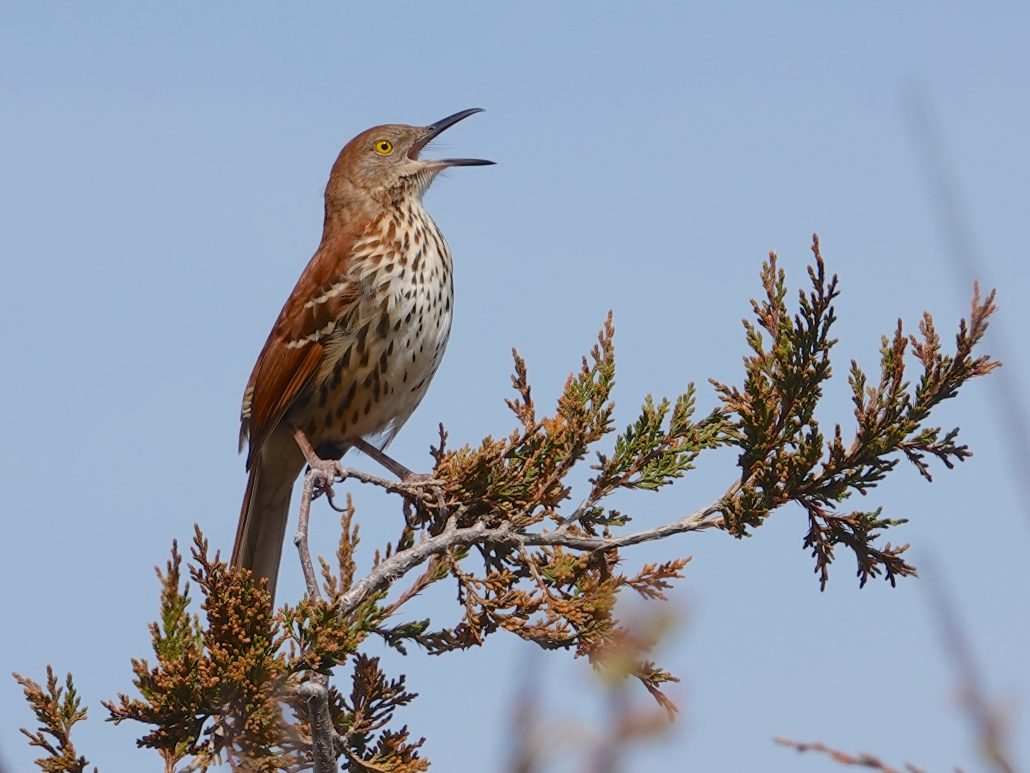By Rick Borchelt

The Lark, sitting upon his earthy bed, just as the morn
Appears, listens silent, then, springing from the waving corn- field, loud
He leads the Choir of Day—trill! trill! trill! trill!
William Blake, 1810
It’s May, and if you’re a light sleeper, you might have a hard time staying asleep with the windows open when the birds start singing in the morning. The dawn chorus of songbirds, beginning an hour or more before sunrise, reaches its crescendo as the sun clears the horizon, dropping off quickly afterwards.
Despite how widely known this dawn chorus is, the phenomenon has long puzzled birdwatchers and biologists alike. What do birds gain by singing in the near-dark when it is chilly and hard to see each other? Answers have not been easy to come by.

Courtesy of Mark Garland
It’s easier to understand some of the physical reasons for the birds’ dawn chorus. Dawn singing coincides with their cyclical surges in hormones like melatonin and testosterone, which rise as a function of day length. And of course male birds are warning away male rivals as they defend their newly established territories. At the same time they are advertising to prospective mates and reinforcing bonds if they are already paired with females. But why such raucous song at dawn rather than during the rest of the day?
The PG-rated reasons I listed above have never fully satisfied scientists. More recent research suggests a more plausible X-rated rationale, at least in part.
Many long-lived raptors and waterfowl, like eagles and geese, mate for life. Barring something unfortunate happening to one of the partners, these pairs call and strut and parade in front of each other to re-establish their bond and prepare themselves physically and socially for the rigors of nesting and bringing up young. This is not the case with most songbirds, though. They are shorter-lived with higher mortality and usually form new pairs every season. With the advent of DNA technology, it’s become increasingly evident that a lot of avian hanky-panky is taking place on the breeding grounds. A number of the eggs in any given clutch may belong to different fathers, and philandering male birds who sneak off into rival territories and have their way with females over there have generally been blamed for — or credited with — this infidelity.
More recent research suggests the female birds may actually be the ones taking their love to town. Fairywrens, small songbirds that are ubiquitous in Australian parks and gardens, offer up the evidence.
Using tiny radio transmitters attached to the birds to monitor their movement, combined with DNA analysis of the eggs in a given clutch, scientists have discovered it’s the females that are sneaking out in the gray dawn and dusk to find other, potentially more fit mates than the ones they have left behind singing their hearts out. The females come back home with eggs fertilized by other males — up to 95% of all fairywren nests hold eggs from different fathers than the one with which the female is pair-bonded. Some birds here in Maryland seem to engage in this kind of revolving-door matrimony, too.
Whatever the reasons for the morning chorus, there’s a distinct order to the songs at dawn in our backyards. Robins usually kick off the singing, with cardinals coming in close behind. Chickadees and titmouse and song sparrows chime in next, followed by doves and thrushes and blackbirds. Warblers are the last to strike up a song, whether they’re migrating through or have stayed on to nest.
When the birds’ urge to sing is strongest, in early spring, mockingbirds and robins may even sing all night long, especially when the moon is bright (or there are street lights nearby). Indeed, Light pollution appears to be disrupting the morning chorus for all birds, pushing their singing earlier and earlier in the pre-dawn hours.
The frequency at which the dawn chorus is sung is getting higher pitched, too, though it’s often not a pitch our ears and hear. Most of the woodland songbirds we see locally sing at a relatively low frequency – these songs carry better in the predawn stillness. But low frequencies are harder to hear in the constant noise of cars, the hum of air conditioners and the clamor of construction.
The dawn chorus is a worldwide phenomenon so widely recognized that it has its own special day: International Dawn Chorus Day, always the first Sunday in May. While I count the Maryland dawn chorus among the most beautiful on Earth, I marvel at dawn choruses from around the world, too. I invite you to come along on a virtual adventure by exploring the links below.
Haskell Peak, California. tinyurl.com/3ndkzvm2
Brisbane, Australia. tinyurl.com/3uvnt8bx
Matto Grosso, Brazil. tinyurl.com/msz79hj5
Hertfordshire, England. tinyurl.com/yunnfn34
###
Have questions for Rick about the world of nature in and around the city, or suggestions for future College Park Wild columns? Drop him a note at rborchelt@gmail.com.







